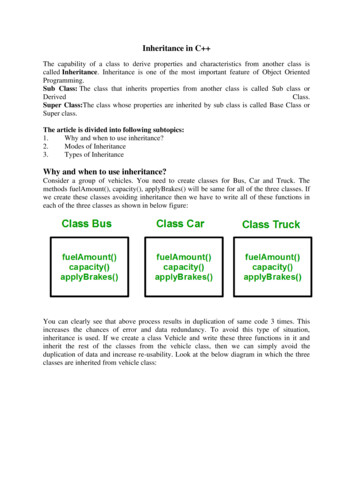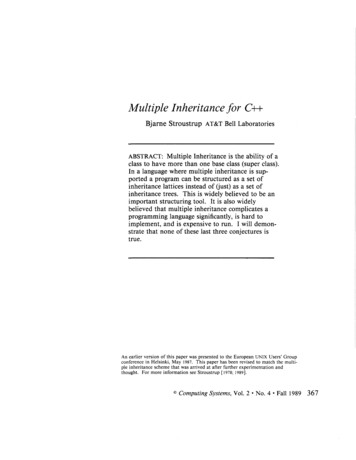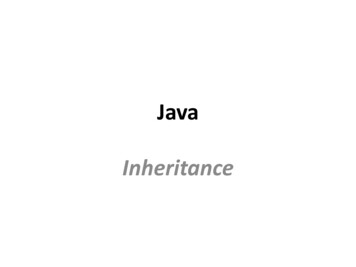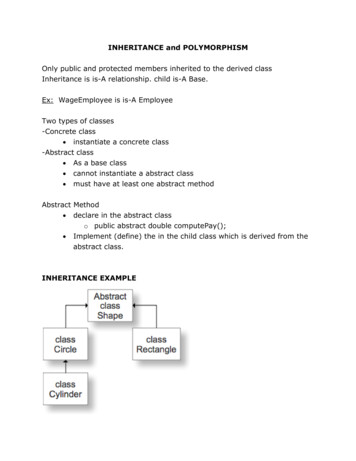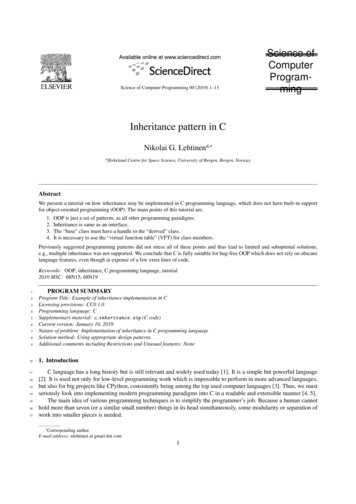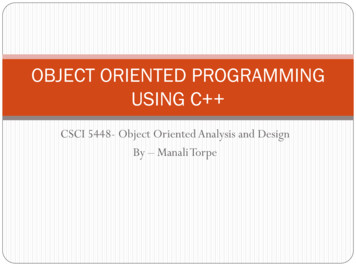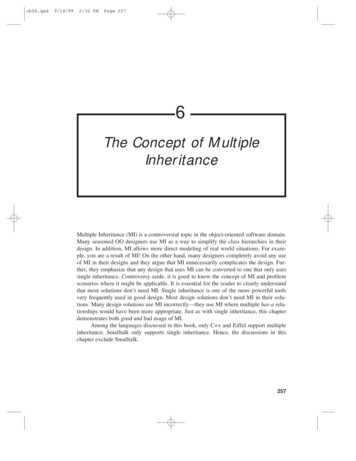
Transcription
ch06.qxd9/14/992:32 PMPage 2576The Concept of MultipleInheritanceMultiple Inheritance (MI) is a controversial topic in the object-oriented software domain.Many seasoned OO designers use MI as a way to simplify the class hierarchies in theirdesign. In addition, MI allows more direct modeling of real world situations. For example, you are a result of MI! On the other hand, many designers completely avoid any useof MI in their designs and they argue that MI unnecessarily complicates the design. Further, they emphasize that any design that uses MI can be converted to one that only usessingle inheritance. Controversy aside, it is good to know the concept of MI and problemscenarios where it might be applicable. It is essential for the reader to clearly understandthat most solutions don’t need MI. Single inheritance is one of the more powerful toolsvery frequently used in good design. Most design solutions don’t need MI in their solutions. Many design solutions use MI incorrectly—they use MI where multiple has-a relationships would have been more appropriate. Just as with single inheritance, this chapterdemonstrates both good and bad usage of MI.Among the languages discussed in this book, only C and Eiffel support multipleinheritance. Smalltalk only supports single inheritance. Hence, the discussions in thischapter exclude Smalltalk.257
ch06.qxd9/14/992:32 PMPage 258258The Concept of Multiple InheritanceChap. 6SIMPLE DEFINITION OF MULTIPLE INHERITANCEMultiple inheritance is a form of inheritance where a class inherits the structure and behavior of more than one base class. In other words, there are multiple (more than one)parent classes for the child (or derived) class.Under single inheritance, a derived class inherits from exactly one base class (it hasa single parent). The scenario is quite simple, both in terms of implementation and concept. Multiple inheritance, on the other hand, involves multiple base classes. The language (C or Eiffel) does not impose any limit on the number of base classes that can beused.1 If the designer is capable of imbibing the complexity of the MI relationship, thelanguage compiler should not have any problems in processing the code. MI can also betreated as a combination of multiple single inheritance relations, all used at once. The bestway to understand the complexity and usage of MI is to use it in an example. And we already have one ready for us from the chapter on single inheritance.THE UNIVERSITY EXAMPLELet’s revisit the solution we implemented in the previous chapter. The hierarchy we created is reproduced below in Fig. 6-1.The class TGraduateStudent was mentioned in the discussions but it was not implemented in the previous chapter. Here is the implementation of the class TGraduateStudent. It is quite simple because a TGraduateStudent has more restrictions on thecourses she can enroll for and also more responsibilities (like research and seminars)./ ** Need to include the header file for TPerson, TStudent, and TTeacherJust for the clarity of this example, here are the enums used earlierenum EStudentStatus { eFullTime, ePartTime, eExchange tudentTTeacherTGraduateStudentFig. 6-11Most design scenarios use two to five base classes, but I have seen some really complicated solutionsusing 10 to 12 base classes.
ch06.qxd9/14/992:32 PMPage 259The University Example259enum EDepartment { eAccounting, eBusiness, eEngineering, eMathematics,ePhysics, eChemistry, eArts, eUnknown };And courses are represented by:class TCourse {public:TCourse(const char name[], long id);other details not shown};Array of department names for easy printingIf you print an enum directly, what you see is an int. But we want to seethe names of the departments. This array of strings is included for thatpurpose.static const char *departmentNames[] {“Accounting”, “Business”,“Engineering”,“Physics”, “Arts”, “Chemistry”, “Unknown” };static const char *statusLabels [] { “Full time”, “Part Time”,“Exchange”, “Unknown” };*//*The Graduate student class.Very similar to the student class but cannot enroll for low levelcourses (less than GRAD COURSE LEVEL). A graduate student always has anadvisor who guides/controls the academic duties of the graduate student.*/// Number of courses a graduate student can enroll for in a semesterconst unsigned MAX COURSES FOR GRAD STUDENT 5;// Cut off course number. A graduate student cannot enroll// in courses below this level (the course number).const unsigned GRAD COURSE LEVEL 400;class TGraduateStudent : public TStudent {public:TGraduateStudent (const char theName[],unsigned long theSSN, // of the graduate studentconst char theBirthDate[],const char theAddress[],EStudentStatus theStatus,EDepartment theDepartment,const TTeacher& advisorInCharge);// Copy ConstructorTGraduateStudent(const TGraduateStudent& source);TGraduateStudent& operator (const TGraduateStudent& source); TGraduateStudent();// Need to override this method because a graduate student is// only allowed enrollment in some predefined courses whereas an// undergraduate student can enroll in any coursebool EnrollForCourse(const TCourse& aCourse);void ChangeAdvisor(const TTeacher& newAdvisor);TTeacher GetAdvisor() const;// Information relevant to a graduate student is printed by// this method
ch06.qxd9/14/992:32 PMPage 260260The Concept of Multiple InheritanceChap. 6virtual void Print() const;// All other methods are inherited without change// because a TGraduateStudent is no different from TStudent// with respect to name, address, dropping from a course etc.// That’s the power of inheritance.private:// The advisor (a faculty member) for this graduate studentTTeacheradvisor;// number of courses already enrolled forunsigned shortnumCourses;};#include iostream.h /* All the arguments for TGraduateStudent are the same as those forTStudent except for the advisorInCharge argument. Hence we just call thebase class (TStudent) constructor and then we initialize the advisorobject in TGraduateStudent using the copy constructor of TTeacher. Wereceive a fully constructed TTeacher object(advisorInCharge) and we needto construct the TTeacher object inside TGraduateStudent using thisargument. This is the scenario where a new object is being created froman existing object. The copy constructor of TTeacher is tailor-made forthis situation */TGraduateStudent::TGraduateStudent(const char theName[],unsigned long theSSN,const char theBirthDate[],const char theAddress[],EStudentStatus theStatus,EDepartment theDepartment,const TTeacher& advisorInCharge)// Initialize the base class object first: TStudent(theName, theSSN, theBirthDate, theAddress,theStatus, theDepartment),// Next initialize the advisor object (uses copy// constructor) of TTeacheradvisor(advisorInCharge){// Now perform the setup for the GraduateStudent part, if anynumCourses 0;}// Usual boiler plate code// The Copy t TGraduateStudent& other): TStudent (other), // call base class copy constructoradvisor(other. advisor),numCourses(other. numCourses){// Nothing to do here}// The Assignment r (const TGraduateStudent& other){// Check assignment to selfif (this &other)
ch06.qxd9/14/992:32 PMPage 261The University Example261return *this;// Call the base class assignment operatorTStudent::operator (other);this- advisor other. advisor;this- numCourses other. numCourses;return *this;}TGraduateStudent:: TGraduateStudent(){// Nothing to do here}// Most of the information to be printed resides in the TStudent class. We// retrieve relevant information from TStudent (and TPerson) and print them// in the right order. In addition, the name of the advisor is printedvoidTGraduateStudent::Print() const{cout “Name: “ GetName() endl;cout “Address: “ GetAddress() endl;EStudentStatus status GetStatus();EDepartment dept GetDepartment();cout “This person is a “ statusLabels[(int)status] “ Graduate Student in the department of “ departments[(int) dept] endl;cout “The Advisor is: “ advisor.GetName() endl;}boolTGraduateStudent::EnrollForCourse(const TCourse& aCourse){// Verify that this grad student hasn’t already exceeded the limit// for number of coursesif ( numCourses MAX COURSES FOR GRAD STUDENT) {cout “Graduate Student cannot enroll for more than “ MAX COURSES FOR GRAD STUDENT “courses” endl;return false;}// Verify that the course level isn’t below the set limit for grad// studentsif (aCourse.GetCourseId() GRAD COURSE LEVEL) {cout “Sorry, Graduate students cannot enroll for courses below “ GRAD COURSE LEVEL “level” endl;return false;}// Otherwise, ask the TStudent base class to do all the mundane work of// enrollment. If enrollment succeeds then increment the # of courses// enrolled for.bool result TStudent::EnrollForCourse(aCourse);if (result true)numCourses ;
ch06.qxd9/14/992:32 PMPage 262262The Concept of Multiple InheritanceChap. 6return result;}// Return the advisor (a TTeacher) object by valueTTeacherTGraduateStudent::GetAdvisor() const{return advisor;}// Assign the newAdvisor object to the existing advisor objectvoidTGraduateStudent::ChangeAdvisor(const TTeacher& newAdvisor){advisor newAdvisor;}Code Reuse with RefinementPay attention to the simplicity of the TGraduateStudent class. The class interface andimplementation appear very simple—don’t be fooled by this simplicity; there are somemajor design features to be understood. Even though a TGraduateStudent also enrollsfor courses, most of the work is done in the TStudent class. The TGraduateStudentclass does re-implement the EnrollForCourse method but it only checks for certain restrictions that are imposed on graduate students. This is a clear example of a situationwhere a derived class method accepts most of the behavior of its base class but needssome refinement (or preprocessing/post-processing). To achieve this goal, the derivedclass method overrides the inherited base class method (EnrollForCourse from TStudent). The implementation of EnrollForCourse in TGraduateStudent does somechecks and then invokes the base class method. And after the base class method (TStudent::EnrollForCourse) finishes its part, the TGraduateStudent::EnrollForCoursemethod does some post-processing based on the outcome of the TStudent::EnrollForCourse. This is another major benefit of inheritance. In the previous chapter, we studiedthe various benefits of inheritance. This capability to enhance/refine a base class methodis one of them. Note that TGraduateStudent does not change the semantics of the behavior of EnrollForCourse—the method is still used for enrolling a student, but more restrictions are enforced. This example illustrates the benefit of code reuse made possibleby using inheritance. Definitely, we don’t want to rewrite all the uninteresting code formanaging the enrollment of a student in several different courses—it has been alreadydone in TStudent. We would like to (re)use it again. But the TGraduateStudent classhas more restrictions on enrollments, so we want to enhance (or extend) the code inherited from the TStudent class. And we have successfully done that in TGraduateStudent. This is classic example of code reuse (Fig. 6-2). Many commercial inheritance hierarchies are built this way. One can imagine that each level of inheritance adds a new layerto the system with more capabilities.22Don’t be of the impression that code reuse is this easy in all situations—it is not. This example has beenchosen to exemplify the concept. Designing a base class for reuse in different scenarios is quite a demandingtask.
ch06.qxd9/14/992:32 PMPage 263The University Example263Inheritance viewed as LayersTStudentTGraduateStudentTPersonBase class withminimal capabilitiesTPersonTTeacherNew layer with morecapabilities that enhanceTPersonLayer with even morecapabilities (in additionto those available in theprevious layers)TStudentTTeacherTGraduateStudentFig. 6-2We also want to manage graduate teaching assistants (GTA) in the university. AGTA is a) a graduate student enrolled in the university, and b) teaches some restricted(usually low level undergraduate) courses. Thus, a GTA has a dual role in the universitysystem: Most of the time a GTA is a (graduate) student but at times she behaves like ateacher. We already have students and teachers in our system but not a combination ofboth. Moreover, the behavior of a GTA is a combination of the behavior of a student anda teacher—and we have already implemented them in our system. There is no fun in implementing the same thing again. We should be able to pull the behavior of TStudent andTTeacher into the class TGradTeachingAsst. Applying our knowledge of single inheritance, this is an extension of the is-a relationship with more than one parent. And thatleads us to MI. The new hierarchy is shown in Fig. 6-3.Class TGradTeachingAsst inherits from both TTeacher and TGraduateStudent. In other words, a TGradTeachingAsst is-a TTeacher and is-a TGraduateStudent at the same time. A TGradTeachingAsst exhibits the behavior of bothTTeacher and TStudent at all times. In the case of single inheritance, we stated thatTStudent is-a TPerson always and also that TGraduateStudent is-a TStudent at alltimes. Now we have extended that definition with TGradTeachingAsst to include twobase classes.One might wonder why this design scenario is considered complex and hard to understand. It seems to be quite simple because we have only scratched the surface of MI.Wait till you see the big picture in the ensuing paragraphs.The class diagrams show the class relationship among the different classes involved. It is also called a class lattice. (The annotated C reference manual uses aslightly different diagram called directed acyclic graph (or simply DAG). More preciselya DAG shows the relation between objects under MI. With single inheritance, a DAGwould be identical to a class diagram that we have been using. But under MI, the DAG isreally the sub-object relationship diagram.)Now let’s see what the syntax looks like in C .
ch06.qxd9/14/992:32 PMPage 264264The Concept of Multiple InheritanceChap. dTeachingAsstFig. 6-3class TGradTeachingAsst : public TGraduateStudent, public TTeacher {// class member functions and data members};This code syntax is also an extension of the single inheritance syntax that we are alreadyfamiliar with. The declaration above says that TGradTeachingAsst has two public baseclasses. The order of the base class names does not change the effect or meaning of the hierarchy. (The order of base class declarations might be important if you are trying tomaintain release to release binary compatibility; see Chapter 13 for details.) We couldhave also writtenclass TGradTeachingAsst : public TTeacher, public TGraduateStudent// class member functions/data};CAUTION{The comma (,) character separates the base class names. And don’t forget the public keyword—it should appear in front of every base class name. If the public keyword is omitted from one or more base class names, those base classes become private base classes(discussed later in this chapter). Be careful.THE MEANING OF MULTIPLE INHERITANCE RELATIONSHIPSAgain, let me use the student-teacher hierarchy. Just as single inheritance, MI also assertsthe is-a relationship among the derived class and its base classes. In this case, the is-a relationship must be valid between TGradTeachingAsst and TGraduateStudent, as wellas between TGradTeachingAsst and TTeacher, at all times. Even though in real life
ch06.qxd9/14/992:32 PMPage 265The MI Scenario265this student behaves as a teacher at some fixed periods of time and as a graduate studentduring most other times, that is not the case with MI implementation code. AnyTGradTeachingAsst object must be capable of being substituted in place of a TGraduateStudent and TTeacher at all times. There is no relaxation of this rule at any time during the lifetime of a TGradTeachingAsst object. In other words, the polymorphic substitution principle must be applicable between TGradTeachingAsst and all other direct andindirect base classes. So we should be able to substitute a TGradTeachingAsst object inplace of TPerson, TStudent, TGraduateStudent, and TTeacher without any change inbehavior. At any time, a TGradTeachingAsst object is-a TPerson, TStudent, TGraduateStudent, and TTeacher. Furthermore, it has the necessary intelligence to take on thebehavior of any of these classes. If the TGradTeachingAsst class (object) is not capableof taking on the behavior of any one of these classes, then rules of MI have been violatedand the MI relationship no longer holds. Stated a little differently, MI signals that a derived class has (at least) the behavior of all of its base classes (and probably more) combined together. This should happen naturally in a well designed MI relationship becausethe derived class automatically inherits the behavior of all of its base classes. The problemis in ensuring the validity of the polymorphic substitution principle under all circumstances.THE MI SCENARIONow let’s look at the implementation of the class TGradTeachingAsst.// Need the class header file for TGraduateStudent here// GraduateTeachingAsst has been added to teacher ranksenum ERank { eInstructor, eGraduateTeachingAssistant, eAsstProfessor,eAssociateProfessor, eProfessor, eDean };class TGradTeachingAsst : public TTeacher, public TGraduateStudent {public:TGradTeachingAsst(const char theName[],unsigned long theSSN, // of the graduate studentconst char theBirthDate[],const char theAddress[],EStudentStatus theStatus,EDepartment studentDepartment,const TTeacher& advisorInCharge,EDepartment teachingDept);TGradTeachingAsst(const TGradTeachingAsst& copy);TGradTeachingAsst& operator (const TGradTeachingAsst& assign); TGradTeachingAsst();// This method intentionally omitted - See text below// void Print()const; ❶void SetStudentsDepartment(EDepartment dept);EDepartment GetStudentsDepartment() const;void SetTeachingDepartment(EDepartment dept);
ch06.qxd9/14/992:32 PMPage 266266The Concept of Multiple InheritanceChap. 6EDepartment GetTeachingDepartment() const;// and probably other functions};There are a number of interesting issues to deal with in the class TGradTeachingAsst.Some of the issues are specific to C and MI, and some are general complications arising out of the use of MI.Methods inherited more than once—Name Conflicts: The virtual method Printis inherited by TGradTeachingAsst from TTeacher and from TGraduateStudent.That leads to complications. Here is a piece of code to clarify things.main(){// This is the advisor for the teaching assistantTTeacherEinstein (“Albert Einstein” , 000, “1-1-1879”,“Germany/USA”, eFullTime, ePhysics);// This is the graduate teaching assistantTGradTeachingAsst Curie(“Marie Curie”, 999887777, “06-29-1867”,“Anytown, France”, eFullTime, eChemistry, Einstein,eMatheMatics);Curie.Print();}In this piece of code, when Print() is invoked on the TGradTeachingAsst object Curie,which Print() method should be called? Since Print() is (intentionally) not implementedin TGradTeachingAsst, an inherited Print() method should be called. ButTGradTeachingAsst inherits two Print() methods, one from TGraduateStudent andanother from TTeacher because of MI. In effect, we are on a road that forks two waysand there is no one at the intersection to guide us correctly.There is a name clash (or name collision) in TGradTeachingAsst with respect tothe method Print(). How should one resolve this conflict? Or a better question is: Whatdoes the language do to prevent such name clashes?Resolving Name Conflicts in C Under C , the name conflict would be a compile-time error, and the classTGradTeachingAsst must re-implement the method Print(). Doing so will make the invocation of Print() unambiguous. So when the TGradTeachingAsst class header file iscreated, it must have the declaration of member function Print() in it.There is an interesting situation here. When the header file for TGradTeachingAsst is created without the declaration of the method Print() in it (as shown on p. 265),should the compiler detect the missing Print() problem (that we might encounter soon)and flag the missing declaration (of Print) as an error when we try to compile the headerfile? Or is it better if the compiler detects the error if and when Print() is invoked on anobject of TGradTeachingAsst later?It is better if the compiler detects the name collision as soon as we try to compilethe header file of TGradTeachingAsst class. This would be early error detection—theproblem is detected at the first possible opportunity and the implementor should fix it immediately. This would prevent more serious problems in the future. Let’s call this conflictdetection at the point of declaration (or early conflict detection). The name collision can
ch06.qxd9/14/992:32 PMPage 267The MI Scenario267Ambiguity of Print() in TGradTeachingAsst(rest of the hierarchy not GradTeachingAsstFig. 6-4REMEMBERonly be detected when the TGradTeachingAsst class declaration file is compiled. This isthe earliest time to detect such errors. Once this error is fixed, clients of TGradTeachingAsst will not have to worry about name collisions when using the TGradTeachingAsstclass.But if the compiler fails to detect the error until some programmer invokes Print() onan object of TGradTeachingAsst it creates new problems for the client. Moreover, theproblem is not in the client’s code—the error is caused by the missing Print() method inTGradTeachingAsst, and the fix for the problem is in the class TGradTeachingAsst,not in the client’s code.3 Imagine what happens if the TGradTeachingAsst class is implemented and shipped in a library to clients without any testing done on the member functionPrint(). As soon as some client tries to invoke the Print() method on an object ofTGradTeachingAsst class, the compiler would generate an error message (about the ambiguity of Print). And the client cannot fix the error because she does not have source codefor the TGradTeachingAsst class. I call this conflict detection at the point of call (or lateconflict detection) because the error is not detected until someone uses the method. Itshould be noted that neither TGraduateStudent nor TTeacher can be blamed for thename clash. After all, they are just like any other class. It is the way these two classes arecombined by TGradTeachingAsst that causes trouble, and the solution is also to be foundthere (in TGradTeachingAsst).Of these two possible error detection schemes, the former (conflict detection at thepoint of declaration) is much superior because it detects errors at the earliest preventingfuture problems. But, none of the compilers that I have used provide this level of service.They report the missing Print method as an error only when it is called on aTGradTeachingAsst object. Hopefully, in the years to come better tools (and compilers)would be available that detect these problems (at least report them as a warning).This demonstrates the need for thorough testing of classes. In particular, each andevery method implemented and inherited by the class must be tested for correct behavior.If this is done diligently, then there wouldn’t be any problems for the clients of the class.Also, designers should pay close attention to methods that they inherit from base classes.The proper design in the discussion above is for TGradTeachingAsst to provide an im3As we shall see later, there is a remedy for such situations (using explicit name qualification) in C butit is only a work-around. The real solution is to fix TGradTeachingAsst.
ch06.qxd9/14/992:32 PM268Page 268The Concept of Multiple InheritanceChap. 6plementation of Print because only TGradTeachingAsst knows what relevant information it should display.close attention to member functions that you inherit from base Payclasses and provide an implementation for every method that you inherit from more than one base class.C Under C , combining classes that contain members (functions and data members)with the same name (and prototype in case of functions) is not an error. The trouble ariseswhen a programmer tries to use the ambiguous name. If class Z inherits from two baseclasses X and Y, both of which contain a function f() (virtual or non-virtual), then invoking f() on an object of Z is ambiguous. The programmer must clarify asto which f() is being invoked (X::f() or Y::f()). But, if a programmer just creates an objectof Z and never invokes f() on Z, then there is no error. Note that these problems are detected at compile time. One need not have to worry about run-time crashes.EIFFELThe scenario is much safer under Eiffel. Here, name conflicts are completely prohibited, and the principle of early conflict detection is applied. When a child class inheritsthe same method from two or more of its parents, then at least one of the inherited methods should be renamed to something more appropriate. Of course, both the inheritedmethods (in our example of TGradTeachingAsst) could be renamed. This scheme ensures that, in a class, any name is always unambiguous. Here is the Eiffel code fragmentthat shows the renaming concept:class TGradTeachingAsst export— all exported features are listed hereinheritTGraduateStudent — name of the inherited classrename Print as GSPrint;TTeacher— name of the other inherited classThis Eiffel scheme prevents name clash propagation. The disadvantage is that a programmer is forced to invent new names for all clashing feature names. For example, renamingPrint inherited from TGraduateStudent as GSPrint is not the best way of doing it because we have to find a new name that clearly reflects the purpose of the method. Butfinding reasonable names that convey their intent is not an easy task. Note that a renamingin one level of the hierarchy may cause a name clash in a subsequent layer of the hierarchy. Note that the renaming facility is not limited to methods—it is applicable to any feature (data members as well as methods). However, it is more frequently used with methods than with data members.It is important to remember that name clashes are not limited to member functions.They are possible with data members also, but it is less probable because it is very rare fora derived class to have access to the data members of its base classes. It is very likely thatclasses have data members with the same name but those data members aren’t usuallyshared with other classes.Here is the (partially) correct version of TGradTeachingAsst:class TGradTeachingAsst : public TTeacher, public TGraduateStudent {public:
ch06.qxd9/14/992:32 PMPage 269The MI Scenario269// other details as before// This method must be overridden for proper behaviorvirtual void Print()const;void SetStudentsDepartment(EDepartment dept);EDepartment GetStudentsDepartment() const;void SetTeachingDepartment(EDepartment dept);EDepartment GetTeachingDepartment() const;};And here is a simple implementation of the member function Print.:void TGradTeachingAsst::Print() const{// We get the appropriate pieces of data and print themEStudentStatus studentStats GetStatus(); // no ambiguity hereEDepartment studentDepartment TGraduateStudent::GetDepartment();EDepartment teachingDepartment TTeacher::GetDepartment();// Explicit qualification needed for GetName andGetIdentificationNumber// Otherwise, it is ambiguous (there are two TPerson objects) in GTAcout “Name: “ TGraduateStudent::GetName() endl;cout “Id Number: “ TGraduateStudent::GetIdentificationNumber() endl;cout “This person is a Graduate Student” endl;cout “ in the department of: “ departments[(int) studentDepartment] endl;cout “The graduate teaching assistantship is in the department: “ departments[(int) teachingDepartment] endl;}Here is a simple implementation of the onst char theName[],unsigned long theSSN, // of the graduate studentconst char theBirthDate[],const char theAddress[],EStudentStatus theStatus,EDepartment studentDepartment,const TTeacher& advisorInCharge,EDepartment teachingDept)// Initialize direct base class TGraduateStudent: TGraduateStudent(theName, theSSN, theBirthDate, theAddress,theStatus, studentDepartment, advisorInCharge),// Initialize direct base class TTeacherTTeacher(theName, theSSN, theBirthDate, theAddress,eGraduateTeachingAssistant, teachingDept){// Implementation code for TGradTeachingAsst}
ch06.qxd9/14/992:32 PM270Page 270The Concept of Multiple InheritanceChap. 6Problem of Ambiguous Base ClassesAnother problem with MI is that of ambiguity in implicit derived class to base class conversion (as described in Chapter 5). With single inheritance hierarchies, there are no problems because there is always one base class for any derived class and the implicit conversion happens automatically. But the scenario isn’t that simple under MI. Consider thisexample (in relation to the Teacher-Student hierarchy).// This is an ordinary overloaded function expecting a// TTeacher argument polymorphicallyvoid foo(const TTeacher& teacher) // ❶{// some code to do processing - not important for this example}// This is an overloaded function foo() expecting a// TGraduateStudent argument polymorphicallyvoid foo(const TGraduateStudent& gradStudent) // ❷{// some code to do processing - not important for this example}main(){// This is the advisor for the gta object belowTTeacher Super Smart Alien(“Super Smart Alien”, 1112223333,“1-1-1900”, “Planet Venus”, eDean, ePhysics);TGradTeachingAsst gta(“Smart Alien”, 777665555, “1-1-2000”,“Planet Mars
tionships would have been more appropriate. Just as with single inheritance, this chapter demonstrates both good and bad usage of MI. Among the languages discussed in this book, only C and Eiffel support multiple inheritance. Smalltalk only supports single inheritance. Hence, the discussions in this chapter exclude Smalltalk. 257



